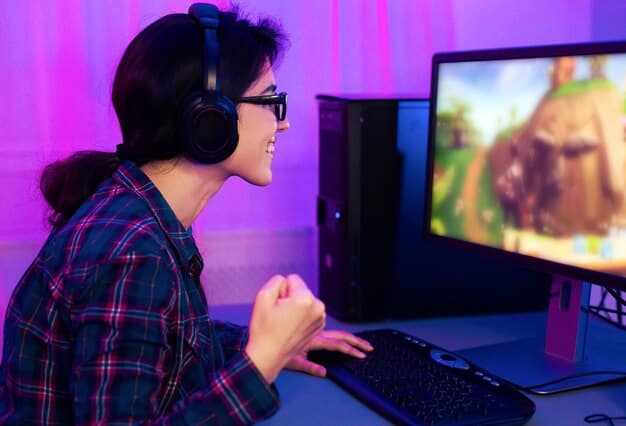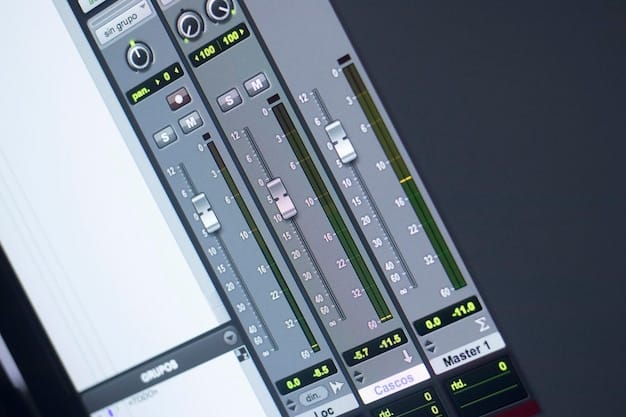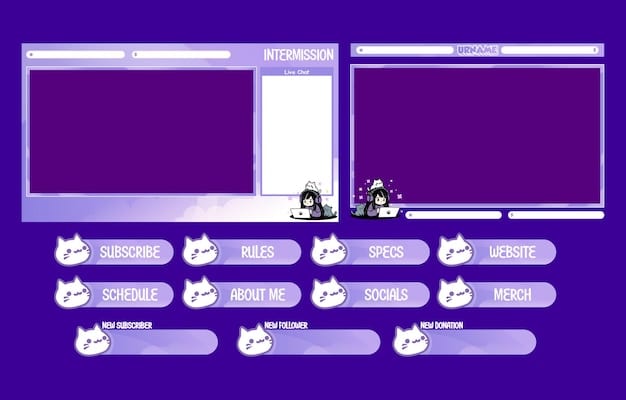PC Gaming Streaming: Your Guide to Starting a Channel and Building an Audience

Starting a PC gaming stream involves understanding the necessary equipment, software setup, and strategies for audience engagement to create a successful and entertaining channel.
Interested in sharing your PC gaming skills with the world? PC gaming streaming: How to start your own channel and build an audience might seem daunting, but with the right approach, it can be an achievable and rewarding endeavor, and this guide will lead you through setup and audience building.
Setting Up Your PC for Gaming Streaming
Before you dive into the world of streaming, ensure your PC is well-equipped to handle both gaming and broadcasting simultaneously. A powerful PC is essential. This section explores the critical hardware and software components required for setting up your PC for gaming streaming, ensuring smooth performance and high-quality content.
Essential Hardware Components
A strong foundation is key for a seamless streaming experience. Consider the following hardware components:
- CPU (Central Processing Unit): A multi-core processor, like an Intel Core i7 or AMD Ryzen 7, is crucial for encoding video in real-time.
- GPU (Graphics Processing Unit): A dedicated graphics card, such as an NVIDIA GeForce RTX or AMD Radeon RX series, handles game rendering and can also assist with encoding.
- RAM (Random Access Memory): Aim for at least 16GB of RAM to prevent performance bottlenecks during gameplay and streaming. 32 GB of RAM is recommended for higher quality streaming and future-proofing.
- Storage: A fast SSD (Solid State Drive) for your operating system, streaming software, and frequently played games will reduce loading times and improve overall responsiveness.
Choosing the Right Streaming Software
Selecting the right software is crucial for encoding your video and managing your stream. Here are some popular options:
- OBS Studio: A free, open-source software widely used for its flexibility and extensive customization options.
- Streamlabs Desktop: A user-friendly alternative to OBS Studio, with built-in widgets and alerts for audience engagement.
- XSplit Broadcaster: A premium software offering advanced features and a streamlined interface for professional streamers.

Setting up your PC properly will prevent you from having to deal with mid-stream interruptions. By selecting the correct hardware and software, you’ll be well on your way to a great experience.
Optimizing Your Stream Settings for Quality and Performance
Once your hardware and software are in place, it’s vital to optimize your stream settings to balance visual quality with performance. This section focuses on fine-tuning your stream settings within your chosen streaming software, ensuring a smooth and enjoyable viewing experience for your audience without compromising your gameplay.
Understanding Bitrate, Resolution, and Frame Rate
These three elements significantly impact the visual fidelity of your stream.
- Bitrate: The amount of data used per second, measured in kbps (kilobits per second). Higher bitrates result in better image quality but require more bandwidth.
- Resolution: The dimensions of your stream, such as 1920×1080 (1080p) or 1280×720 (720p). Higher resolutions provide sharper visuals but demand more processing power.
- Frame Rate: The number of frames displayed per second, such as 60fps (frames per second) or 30fps. Higher frame rates result in smoother motion but require more processing power and bandwidth.
Testing and Adjusting Your Settings
Finding the optimal balance requires experimentation. Consider these steps:
- Run a Speed Test: Use a reliable internet speed test to determine your upload speed. Your bitrate should be significantly lower than your upload speed to avoid buffering.
- Start with Recommended Settings: Most streaming platforms provide recommended settings based on your resolution and frame rate.
- Monitor Your Stream: Use the streaming software’s performance monitoring tools to track CPU usage, frame drops, and network latency.
- Adjust Incrementally: If you experience issues, lower your bitrate, resolution, or frame rate in small increments until the stream stabilizes.
Tweaking your settings may take time, but you’ll eventually settle into settings that balance quality and performance. Monitor and adapt settings to handle any issues.
Choosing the Right Streaming Platform
Selecting the right platform is crucial for reaching your desired audience and building a community. This section dives into the most popular streaming platforms available to PC gamers, highlighting their unique features, audience demographics, and monetization options to help you make an informed decision.
Twitch: The King of Gaming Streams
Twitch is the dominant platform for gaming streams, boasting a massive and engaged audience. Key features include:
- Affiliate Program: Allows streamers to monetize their content through subscriptions, donations, and ad revenue.
- Interactive Features: Offers tools like chat, polls, and extensions to engage viewers.
- Discoverability: Provides channels and tags that allow new viewers to find streams.
YouTube Gaming: Leveraging the Power of Video
YouTube Gaming offers a different approach, integrating live streams with on-demand video content. Advantages include:
- Discoverability: Benefits from YouTube’s vast search engine and recommendation algorithms.
- Monetization: Offers various monetization options including ads, sponsorships, and channel memberships.
- Content Integration: Allows streamers to create complementary video content that enhances their live streams.

Smaller Platforms and Niche Communities
Consider exploring smaller platforms or niche communities if you have a specific focus or target audience. Consider niche communities.
Finding the right community for your type of gaming content takes trial and error. Before committing to a platform, make sure you understand its features and the community it attracts. Explore several platforms to see which works best for you.
Engaging Your Audience and Building a Community
Creating a successful stream is about more than just playing games; it’s about building relationships with your viewers. This section outlines practical strategies for engaging your audience, fostering a sense of community, and turning casual viewers into loyal fans. These strategies provide a strong foundation for a fun and engaging stream.
Interacting with Chat and Comments
Active interaction is key to keeping viewers engaged. Consider these tips:
- Respond Promptly: Acknowledge and respond to comments and questions in a timely manner.
- Personalize Interactions: Use viewers’ names and reference previous conversations to create a personal connection.
- Encourage Discussion: Ask open-ended questions to spark conversation and encourage viewers to share their thoughts.
Creating a Unique Stream Identity
Stand out by developing a unique brand and personality. Here are some ways:
- Choose a Catchy Name: Select a memorable and relevant username that reflects your stream’s focus.
- Design Custom Overlays and Emotes: Create visually appealing graphics that enhance your stream’s aesthetics and branding.
- Develop a Consistent Style: Establish a consistent tone, humor, and content style that resonates with your target audience.
Building a community is an ongoing process that requires effort and consistency. When building your community, follow these tips: be prepared to interact with viewers, develop a unique brand, and have fun.
Promoting Your Stream and Growing Your Channel
To attract more viewers, it’s essential to actively promote your stream and expand your reach. This section covers effective strategies for marketing your stream, leveraging social media, and collaborating with other streamers to grow your channel and increase your visibility.
Leveraging Social Media Platforms
Social media is a powerful tool for reaching potential viewers. Here’s how to use it effectively:
Effective Promotion Strategies
Promoting your channel consistently increases visibility. Here are some practical strategies:
- Create Engaging Content: Share highlights, clips, and behind-the-scenes content on social media to entice viewers.
- Use Relevant Hashtags: Incorporate relevant hashtags to reach a wider audience interested in your stream’s content.
- Engage with Other Streamers: Interact with other streamers and participate in relevant communities to build relationships and gain exposure.
- Consistent Schedule: Post your stream schedule across all platforms to keep viewers informed.
- Cross-Promotion: Promote your stream on other platforms and vice versa to maximize reach.
- Run Contests and Giveaways: Incentivize viewers to engage with your stream and social media channels through contests and giveaways.
Equipment Upgrades for Better Streaming Quality
Boosting your streaming quality sometimes requires upgrading your equipment. Stream quality often dictates how many viewers you can attract. This section identifies which equipment upgrades offer the greatest return on investment, providing more options for enhancing the clarity of your video, the quality of your audio, and the overall professionalism of your stream.
Improving Audio Quality
Clear and crisp audio is paramount for a professional stream. Consider these upgrades:
- Dedicated Microphone: Invest in a high-quality USB microphone, such as a Blue Yeti or Rode NT-USB, for superior sound capture.
- Audio Interface: Use an audio interface to connect professional-grade microphones and instruments for advanced audio control.
- Acoustic Treatment: Add acoustic panels or foam to your streaming area to minimize echo and background noise.
| Key Point | Brief Description |
|---|---|
| ⚙️ PC Setup | Configure hardware and software for optimal streaming. |
| 📈 Stream Settings | Adjust bitrate, resolution, and frame rate. |
| 📢 Promotion | Use social media consistently and engage. |
| 👥 Engagement | Interact with chat and personalize. |
Frequently Asked Questions
▼
At least an Intel Core i5 or AMD Ryzen 5 processor, 8GB of RAM, and a dedicated GPU like an NVIDIA GeForce GTX 1050 or AMD Radeon RX 560 are recommended for streaming at 720p 30fps.
▼
OBS Studio and Streamlabs Desktop are both great options for beginners due to their user-friendly interfaces and extensive tutorials. Streamlabs is often easier to setup.
▼
While not essential, a webcam can significantly enhance viewer engagement by allowing them to see your reactions and expressions for a more personal connection. You can always add one later.
▼
Consistency is key. Aim to stream at least 2-3 times per week at set times to establish a schedule for your viewers. This helps build anticipation.
▼
Consider adding variety with Q&A sessions, game reviews, tutorials, or even just chatting with your audience to keep things fresh and engaging. Be creative in how you entertain the viewers.
Conclusion
Starting your own PC gaming stream is an adventure in itself, offering you the chance to build a community, share your passion, and even make a living. Embrace the journey, stay consistent, and most importantly, have fun, and you may be surprised where the road leads.





